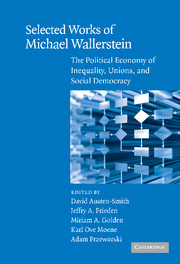 Selected Works of Michael Wallerstein
Selected Works of Michael Wallerstein Published online by Cambridge University Press: 27 January 2010
Few features of economic, social, or political life in industrialized democracies differ as much as the relative size of the trade union movement. The current density of union membership in the labor force ranges over almost the entire spectrum from above 90% in Sweden to under 20% in the United States (Goldfield 1987, 16). The level of unionization varies far more than such other characteristics of the labor force as the sectoral distribution of workers, the share of wages in GNP, rates of unemployment, or even the size of the public sector. Unionization rates vary more than such other forms of popular mobilization as electoral turnout or the share of the vote received by parties bearing communist, socialist, social democratic, or labor labels.
The economic effects of high levels of unionization are ambiguous. Unions that are large relative to the economy may simultaneously have more power in the labor market and more of an incentive to moderate their wage demands. A union that covers only a small fraction of an industry's work force, for example, can gain wage increases partly at the expense of employment among nonunion members, provided that union members have specialized skills not readily available elsewhere. In contrast, an industrial union covering the entire work force would be concerned with employment in all job categories. Bigger unions are not necessarily more militant unions (Cameron 1984; Olson 1982, chap. 4).
To save this book to your Kindle, first ensure [email protected] is added to your Approved Personal Document E-mail List under your Personal Document Settings on the Manage Your Content and Devices page of your Amazon account. Then enter the ‘name’ part of your Kindle email address below. Find out more about saving to your Kindle.
Note you can select to save to either the @free.kindle.com or @kindle.com variations. ‘@free.kindle.com’ emails are free but can only be saved to your device when it is connected to wi-fi. ‘@kindle.com’ emails can be delivered even when you are not connected to wi-fi, but note that service fees apply.
Find out more about the Kindle Personal Document Service.
To save content items to your account, please confirm that you agree to abide by our usage policies. If this is the first time you use this feature, you will be asked to authorise Cambridge Core to connect with your account. Find out more about saving content to Dropbox.
To save content items to your account, please confirm that you agree to abide by our usage policies. If this is the first time you use this feature, you will be asked to authorise Cambridge Core to connect with your account. Find out more about saving content to Google Drive.